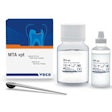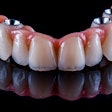For this week's video clinical tip, courtesy of CDOCS, Dr. Farhad Boltchi takes readers through an in-depth look at flapless dental implant surgery so you know when to incorporate this procedure and when to avoid it.
Video transcript
"This is Dr. Farhad Boltchi with CDOCS, and in this tip of the day video, I will be discussing flapless implant surgery.
"Now in our CDOCS implant workshops, we get a lot of questions regarding when to do flapless implant surgery, because that is obviously something very attractive and very easy, both for the implant surgeon and for the patient to perform. So we can see here, if we have got a case such as this where we have got adequate tissue, and when we plan our case, we see that we have got also adequate bone, then this case becomes a very straightforward case where, especially with guided surgery, we can perform flapless implant surgery.
"When we do guided surgery, most guided systems, such as in this case with the Astra EV system, have a guided punch, where we can use this guided punch to very accurately remove the tissue from the site and then proceed with the preparation of the site and with implant placement through the guide. Now, even if we do this flapless, I still definitely recommend and prefer to remove the tissue with a punch so that we basically drill into the bone and not just through the tissue, because if we do that, then there is the danger where we take epithelial cells and tissue cells from the surface into the osteotomy.
"Once this is done, we can place the standard healing caps, or such that, in this case, a custom tissue-former to go ahead and start forming the tissue around this side for our restoration.
"Now it is very important to realize when to avoid to do flapless implant placement, or flapless implant surgery, where the first thing is that if we don't have enough keratinized tissue in a site, we don't want to remove that keratinized tissue by doing the punch. So we should always ensure that after we do the punch, we have at least 2 mm of keratinized tissue remaining, both on the buccal and also on the lingual of the specific implant. We can do this by trying in the punch by hand through the guide to see how much tissue would be left over.
"The second thing is that if we have to do more extensive bone profiling, or bone reshaping, which might be necessary in some cases, then the flapless implant surgery does not become an option, because then we have to reflect the flap to be able to do that bone reshaping.
"And the third thing, obviously, is that if we are doing bone grafting, we have to perform a flap to be able to place the implant.
"So these are the three scenarios where to avoid flapless implant surgery. So I hope this tip of the day has been helpful to you, and for more tips such as this, please visit CDOCS.com, or visit us at one of our implant workshops, which we teach at CDOCS, where we go into detailed discussion of implant-related topics."



















